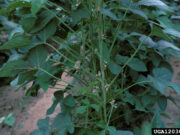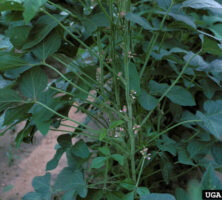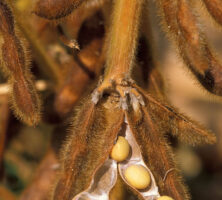Soybeans, introduced to Georgia in the eighteenth century, are raised today in the state as a source of cooking oil and animal feed. Researchers at the University of Georgia (UGA) are also examining the crop’s potential for the production of biofuel and as a more palatable foodstuff.
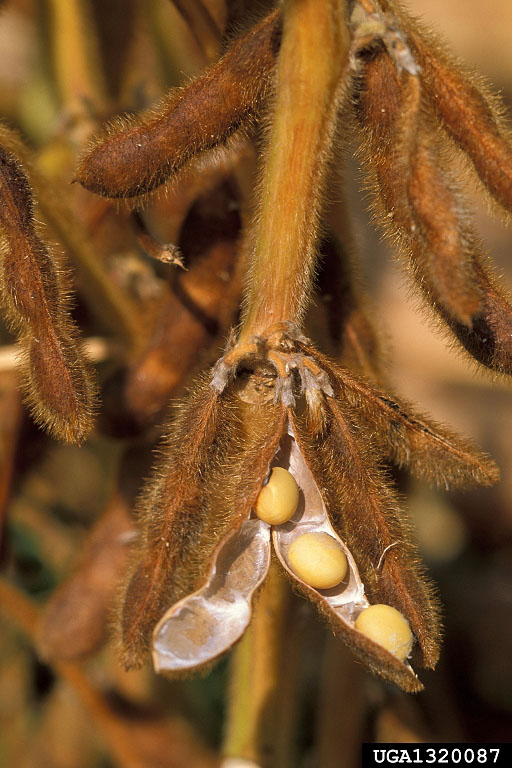
Photograph by Scott Bauer, USDA Agricultural Research Service. Courtesy of IPM Images
Originating in China, the soybean is a major crop worldwide. The first soybean crop raised in America is thought to have been planted in Georgia by Samuel Bowen in 1765. After the East India Company ship on which Bowen was employed arrived in the American colonies from China, Bowen declined to return aboard and instead settled in Savannah, where he planted and harvested a soybean crop.
With encouragement from the U.S. Department of Agriculture, which was founded in 1862, farmers in the southern states began planting soybeans as forage for their livestock. In 1904 agricultural scientist George Washington Carver of Tuskegee University in Alabama discovered that soybeans were a valuable source of protein and oil. He also discovered that soybeans worked well as a cover crop, which is a crop planted to enrich the soil after the major crop is harvested.
Soybean production in the United States has increased continually since the nineteenth century. Today, the nation’s farmers plant nearly 77 million acres of soybeans and rely on the crop for animal feed. Livestock in the United States consume about 25 million tons of soybean meal annually. Soybean farmers in Georgia plant an average of 180,000 acres each year, significantly less than other crops. For example, farmers in the state devote 1.3 million acres to cotton and 755,000 acres to peanuts. In 2004 Georgia farmers produced 8.37 million bushels of soybeans, and the state soybean crop was valued at $47.5 million.
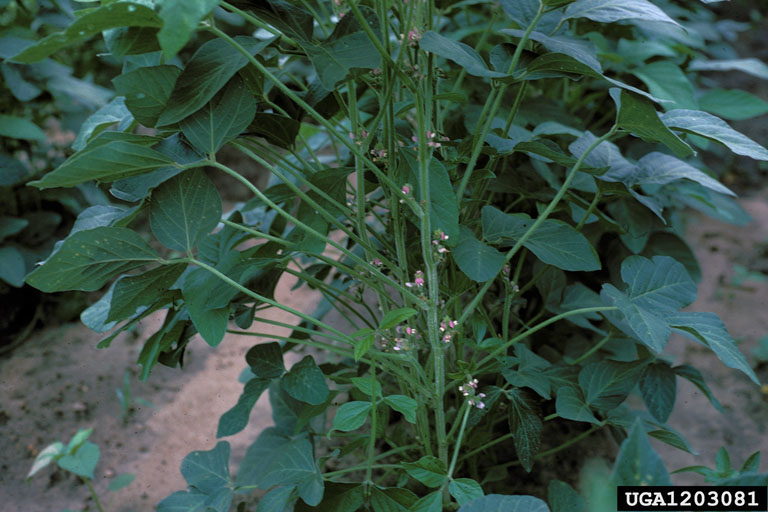
Photograph by Carl Dennis, Auburn University. Courtesy of IPM Images
Soybeans present unique challenges for Georgia farmers. Traditional varieties, grown primarily in the Midwest, are very susceptible to drought in the sandy soils of Georgia’s coastal plain. According to soybean specialists, the potential for drought in Georgia makes soybeans less economically feasible than other crops. Also, Georgia farmers use their irrigated acres for such higher-value crops as cotton, peanuts, and vegetables because they are generally paid less for soybeans than are midwestern growers.
Georgia farmers who plant soybeans grow them primarily as an oilseed crop—the beans are harvested and crushed to produce oil for cooking. The meal produced by crushing the beans is used as animal feed and as a food ingredient. Soybean oil can also be used to produce biodiesel, a fuel made from such renewable materials as vegetable oils or animal fats. Scientists with the University of Georgia College of Agricultural and Environmental Sciences are conducting biodiesel feasibility studies and biotechnology research on several crops, including soybeans.
UGA researchers are also working with a new variety of soybean, L-Star, which could have greater appeal for Georgia farmers. Soybean flowering is dictated by night length, and unlike traditional varieties, L-Star would get the day and night lengths it requires in Georgia. Developed by the National Agricultural Research Organization in Japan, L-Star is touted for its “less beany” taste. The naturally deodorized soybean does not contain lipoxygenase, the enzyme linked to the unpopular flavor. Food scientists at UGA have also developed a soy milk and tofu with L-Star beans.
A major obstacle to L-Star’s success in Georgia is its fragility. In 2005 farmers faced problems at harvest time because the L-star pods shatter easily. When the beans dry, the pods open and the beans fall out before the farmer’s combine can harvest the crop. Researchers at UGA are working to help farmers address the harvesting problems.


